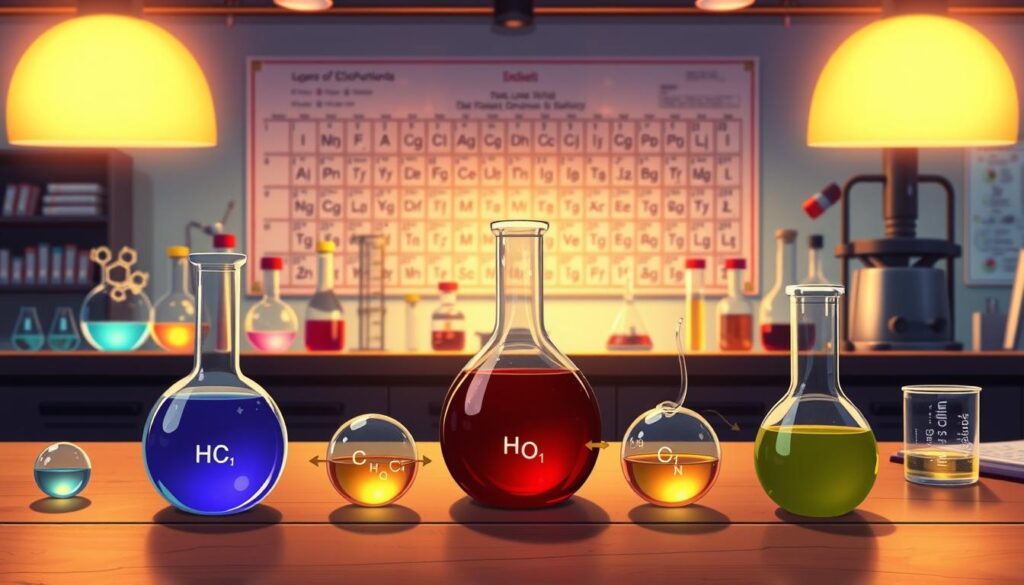Chemical reactions are everywhere, like iron rusting or fuel burning. Knowing the types of chemical reactions is key in chemistry, environmental science, and cooking. Our free PDF download lets you practice identifying and balancing chemical equations.
Our chemical reactions worksheet printable covers the five main types: synthesis, decomposition, combustion, single replacement, and double replacement. By doing the examples and exercises, you’ll get better at recognizing and balancing chemical equations. This skill is essential for chemistry.
Key Takeaways
- Identify the five main types of chemical reactions.
- Practice balancing chemical equations with our worksheet.
- Improve your understanding of chemistry with practical exercises.
- Access a free PDF download to start learning immediately.
- Enhance your skills in chemistry and related fields.
Understanding Chemical Reactions
Chemical reactions change one or more substances into new ones. This idea is key in chemistry. It helps us understand many chemical processes.
To get chemical reactions, you need to know what they are and why they matter. You’ll learn how they are sorted and why they’re important in chemistry.
Definition of Chemical Reactions
A chemical reaction changes substances by breaking and making bonds. This makes new substances with different traits. It’s shown in a chemical equation.
For example, hydrogen and oxygen making water is a chemical reaction. The equation shows how hydrogen and oxygen turn into water: 2H2 + O2 → 2H2O.
Importance in Chemistry
Chemical reactions are the core of chemistry. They show how substances change and interact. Knowing how to sort these reactions helps us predict and balance chemical equations.
Understanding chemical reactions lets us see how different processes work. For example, the types of chemical reactions practice worksheet helps you practice and improve your knowledge.
| Type of Reaction | Description | Example |
|---|---|---|
| Synthesis | Two or more substances combine to form a new compound. | 2H2 + O2 → 2H2O |
| Decomposition | A single compound breaks down into simpler substances. | 2H2O → 2H2 + O2 |
| Single Replacement | One element replaces another in a compound. | Zn + CuSO4 → ZnSO4 + Cu |
Overview of the Types of Chemical Reactions
Chemical reactions come in many types, each with its own traits. Knowing these types helps us understand and predict what happens in chemical reactions. Here, we’ll look at the main types of chemical reactions.
Synthesis Reactions
Synthesis reactions happen when two or more substances mix to make a new compound. This is also called a composition reaction.
Decomposition Reactions
Decomposition reactions are the opposite. Here, one compound splits into two or more simpler substances.
Single Replacement Reactions
In single replacement reactions, one element swaps places with another in a compound. This is also known as a substitution reaction.
Double Replacement Reactions
Double replacement reactions happen when two compounds swap partners. This results in two new compounds being formed.
| Type of Reaction | Description | Example |
|---|---|---|
| Synthesis | Two or more substances combine to form a new compound. | 2H2 + O2 → 2H2O |
| Decomposition | A single compound breaks down into simpler substances. | 2H2O → 2H2 + O2 |
| Single Replacement | One element replaces another in a compound. | Zn + CuSO4 → ZnSO4 + Cu |
| Double Replacement | Two compounds exchange partners to form new compounds. | NaCl + AgNO3 → NaNO3 + AgCl |
Knowing the different types of chemical reactions helps you solve harder chemistry problems. Use our types of chemical reactions quiz and identifying types of chemical reactions worksheet to practice.
Synthesis Reactions Explained
In chemistry, synthesis reactions are very important. They combine elements or compounds to make something new. You see these reactions in many chemical processes. Knowing about them is essential for chemistry mastery.
Key Features of Synthesis Reactions
Synthesis reactions join different substances to make a new one. You can spot them by looking at the chemical equation. It shows many reactants making one product.
For example, sodium (Na) and chlorine (Cl2) mix to make sodium chloride (NaCl), or table salt.
Characteristics of synthesis reactions include:
- Combination of two or more reactants
- Formation of a single product
- Often involve the release of energy
Illustrative Examples of Synthesis Reactions
Here are some examples to help you understand synthesis reactions better. The mix of hydrogen gas (H2) and oxygen gas (O2) makes water (H2O). Another example is nitrogen (N2) and hydrogen (H2) making ammonia (NH3).
To get better at spotting and balancing these reactions, use a chemical reactions worksheet answers or a balancing chemical equations worksheet. These tools will help you learn and practice.
Decomposition Reactions Explained
In this section, we’ll explore decomposition reactions. They are a key type of chemical reaction. You might see them in a chemical reactions worksheet high school curriculum. These reactions break down a single compound into two or more simpler substances.
Understanding decomposition reactions is crucial in chemistry. They show how complex substances can break down into simpler parts. Knowing about them helps you tackle more advanced chemistry topics.
Characteristics of Decomposition Reactions
Decomposition reactions have unique features. They break down a single compound into multiple products. This can be shown as: AB → A + B.
These reactions also need energy to start. This energy can be heat, light, or electricity. It helps break the chemical bonds in the compound.

Examples of Decomposition Reactions
A classic example is calcium carbonate (CaCO3) breaking down into calcium oxide (CaO) and carbon dioxide (CO2): CaCO3 → CaO + CO2. This reaction is important in many industrial processes. It’s often used in chemical reactions worksheet high school resources.
Another example is hydrogen peroxide (H2O2) breaking down into water (H2O) and oxygen (O2): 2H2O2 → 2H2O + O2. This reaction is often helped by the enzyme catalase, found in many living things.
By understanding decomposition reactions, you’ll be ready for chemical reactions worksheet high school exercises. You’ll also be able to apply your knowledge in real-world situations.
Single Replacement Reactions Explained
Single replacement reactions are key in chemistry. They happen when one element swaps places with another in a compound. These reactions help us understand many chemical processes.
To get single replacement reactions, knowing their basics is important. These reactions happen when a more reactive element takes the place of a less reactive one. This can be shown as: A + BC → AC + B, where A is more reactive than B.
Characteristics of Single Replacement Reactions
Single replacement reactions have some key traits:
- They are about swapping one element for another in a compound.
- The elements’ reactivity decides if the reaction will happen.
- The reaction makes a new compound and changes the element.
For example, zinc and copper(II) sulfate react. Zinc takes copper’s place, making zinc sulfate and copper. This is a clear example of a single replacement reaction.
Examples of Single Replacement Reactions
Here are a few examples to better understand single replacement reactions:
| Reaction | Description |
|---|---|
| Zn + CuSO4 → ZnSO4 + Cu | Zinc displaces copper from copper(II) sulfate. |
| Pb + FeSO4 → PbSO4 + Fe | Lead displaces iron from iron(II) sulfate. |
| Mg + 2HCl → MgCl2 + H2 | Magnesium displaces hydrogen from hydrochloric acid. |
For more practice, check out a types of chemical reactions practice worksheet.
Learning about single replacement reactions helps you solve more complex chemical problems. Try different examples and worksheets to improve your understanding.
Double Replacement Reactions Explained
In chemistry, double replacement reactions are key in making new compounds. They happen when ions swap between two reactants, creating two new compounds.
Characteristics of Double Replacement Reactions
These reactions are about swapping partners in ionic compounds. This usually happens when they’re in water. The equation for this is:
AB + CD → AD + CB
Here, A and C are cations, and B and D are anions. The cations swap anions to make new compounds.
Examples of Double Replacement Reactions
Let’s look at some examples to get a better grasp.
1. Sodium phosphate and potassium hydroxide react:
Na3PO4 + 3KOH → 3NaOH + K3PO4
Sodium ions (Na+) from sodium phosphate mix with hydroxide ions (OH–) from potassium hydroxide. This makes sodium hydroxide (NaOH). Potassium ions (K+) and phosphate ions (PO43-) make potassium phosphate (K3PO4).
2. Silver nitrate and sodium chloride react:
AgNO3 + NaCl → AgCl + NaNO3
Here, silver ions (Ag+) from silver nitrate mix with chloride ions (Cl–) from sodium chloride. This makes silver chloride (AgCl). Sodium ions (Na+) and nitrate ions (NO3–) make sodium nitrate (NaNO3).
Let’s summarize some key examples in a table:
| Reactants | Products |
|---|---|
| Na3PO4 + 3KOH | 3NaOH + K3PO4 |
| AgNO3 + NaCl | AgCl + NaNO3 |
| CaCl2 + Na2CO3 | CaCO3 + 2NaCl |

Understanding double replacement reactions helps us see how compounds interact and form new ones. This knowledge is key in chemistry and related fields.
Balancing Chemical Equations
Learning to balance chemical equations is key in studying reactions. It makes sure the law of conservation of mass is followed. This means the number of atoms for each element is the same on both sides.
Importance of Balancing Equations
Balancing chemical equations is more than just a task. It’s crucial for understanding and predicting reaction outcomes. By balancing, you can find the stoichiometric ratios between reactants and products. This is important for figuring out the amounts needed or produced.
It also helps find the limiting reactant and the theoretical yield. This makes it a must-have tool in both school and industry.
Tips for Balancing Chemical Equations
To balance chemical equations well, follow these steps:
- First, find elements that only appear once on each side.
- Then, balance these elements by adjusting the coefficients.
- After that, balance elements that appear more than once.
- Use coefficients in front of formulas to balance, without changing the formulas.
- Finally, check your work to make sure each element has the same number of atoms on both sides.
Mastering balancing chemical equations will improve your understanding of reactions. It will also help you predict and analyze their outcomes better.
Practical Applications of Chemical Reactions
Chemical reactions are important in many areas like energy, medicine, and making things. They help make the goods and services we use every day.
Real-World Examples
Chemical reactions are key in making medicines. They help create drugs and other treatments. For example, aspirin is made through a chemical reaction between salicylic acid and acetic anhydride.
In the energy field, chemical reactions help turn crude oil into fuel like gasoline and diesel. They also help make electricity in batteries.
Significance in Industry
Chemical reactions are very important in industry. They help make many products, like plastics, fertilizers, cosmetics, and food additives.
The Haber-Bosch process is a big deal. It turns nitrogen and hydrogen into ammonia. This ammonia is used to make fertilizers that help grow food worldwide.
| Industry | Application | Example |
|---|---|---|
| Pharmaceuticals | Synthesis of drugs | Aspirin production |
| Energy | Refining crude oil | Production of gasoline and diesel |
| Agriculture | Fertilizer production | Haber-Bosch process for ammonia |
Chemical reactions are crucial in many industries. They help the world economy and improve our lives.
“Chemistry is not just about reactions; it’s about understanding the world around us and using that knowledge to create a better future.”
Using the Types of Chemical Reactions Worksheet
Our types of chemical reactions worksheet helps you identify and balance chemical reactions. It covers synthesis, decomposition, single replacement, and double replacement reactions. This makes you good at balancing chemical equations, a key skill in chemistry.
Benefits of the Worksheet
The worksheet has many benefits. It gives you lots of practice in identifying and balancing chemical equations. You can:
- Improve your understanding of chemical reactions
- Enhance your ability to balance chemical equations
- Prepare effectively for chemistry exams
A key advantage is its wide coverage of reaction types. This makes sure you know a lot about different reactions.
How to Utilize the Worksheet Effectively
To get the most from the worksheet, follow these steps:
- First, review the different types of chemical reactions in the worksheet.
- Then, practice identifying the type of reaction for each equation.
- Balance the chemical equations given.
- Check your answers to see how well you did and what you need to work on.
Here’s a quick look at the main reaction types and what they’re about:
| Reaction Type | Characteristics | Example |
|---|---|---|
| Synthesis | Two or more substances combine to form a new compound | 2H2 + O2 → 2H2O |
| Decomposition | A single compound breaks down into simpler substances | 2H2O → 2H2 + O2 |
| Single Replacement | One element replaces another in a compound | Zn + CuSO4 → ZnSO4 + Cu |
| Double Replacement | Two compounds exchange partners to form new compounds | Na2SO4 + BaCl2 → BaSO4 + 2NaCl |
By following these tips and using the worksheet well, you’ll get better at chemical reactions.
Downloading the Free PDF Worksheet
Now that you’ve learned about different chemical reactions, it’s time to practice. Our free PDF worksheet is here to help. It’s designed to make sure you understand synthesis, decomposition, single replacement, and double replacement reactions.
Accessing the Worksheet
To get the chemical reactions worksheet, just click the link. It has lots of problems and examples. Plus, there’s a section for answers to check your work.
Printing and Usage Guidelines
For the best print, make sure your PDF viewer is set right. Print the worksheet on 8.5 x 11-inch paper. Use it as a study guide or in class. It’s great for teachers too, with answers to help teach.



















